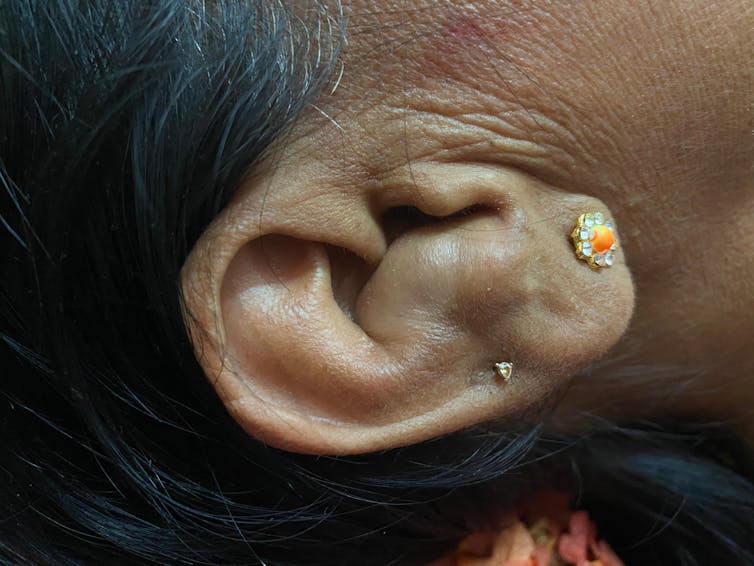An ear is like an iceberg – much of it is out of sight. The only visible part is the auricle – the seashell shaped structure made of bendy cartilage, covered in skin. Its main role is to act as a trumpet, filtering and funnelling sound waves down into the middle, then the inner ear, where they are converted into our sense of hearing.
A medical ear examination usually involves an inspection of the canal, using an instrument called an otoscope. This is usually to investigate more common ear conditions – an infection, or a clog of wax.
But the auricle – also known as the external ear – can also tell tales about your health, family traits and even whether you play high contact sports.
The shape of every ear is unique as a fingerprint and each part has a name. The fleshy, dangly bit at the bottom is the lobule – or ear lobe. The folded top portion, which curves along the edge of the ear, is the helix – named for its shape – and the two prominent areas that sit next to the canal are the tragus and antitragus.
The word “tragus” is derived from the Greek for goat. This is because the tragus is usually covered in hairs, giving it a similar appearance to a billygoat’s chin. Have a feel for yourself – you may not have realised the hairs were there.
Ear genetics
Earlobes feel different to the rest of the ear. They lack cartilage so feel soft and squishy, rather than firm and bendy.
But the appearance of the earlobe can vary according to your genes – they’re either free (with a dangly bit) or attached (attached directly to the head).
It was initially believed that the allele – a form of a gene – that codes for free lobes is dominant, which means that you only have to have one copy of the gene, either from your mother or your father. Attached lobes were understood to come from recessive alleles, which means that you must inherit them from both parents. That made free lobes more common.
But we now know it’s not that straightforward. A spectrum exists between free and attached lobes, coded by many different genes. Take a look at your own lobes, the people you live with, and some people in the public eye. They range in size and shape – from Charlize Theron and her free earlobes to Gwyneth Paltrow’s attached lobules.
Also, wearing heavy earrings can elongate lobes and alter their appearance, too.


Earlobes are rich with sensory nerve fibres, which gives them a reputation for being an erogenous zone – sensitive to touch, breath and nibbles.
Gout and tophi
Gout is on the rise. Not just a disease of the Georgian aristocracy, it is a systemic condition that can affect the joints, heart, kidneys – and even ears.
It’s caused by high levels of uric acid in the bloodstream, which turns into crystals. If these accumulate in the joints, they can inflame and erode them, causing painful swelling. High uric acid is also associated with higher levels of “bad” cholesterol, and is associated with cardiovascular diseases, such as high blood pressure and strokes.
Occasionally, uric acid crystals can develop under the skin. These can appear as little lumps called tophi, that often form in the tissue around joints, but also in the ears.
Tophi are firm and look like pebbles, which is where they get their name from (the singular tophus is Latin for stone). If tophi break through the skin, or are removed surgically, they usually look like chalk.
Tophi usually form over long periods of time, and are only ever associated with gout.
Cauliflower ear
Stuck out on the sides of our heads, in various degrees of protrusion, our ears are exposed and potentially open to damage. Earrings can easily tear through piercings if they get caught. Ears are often subjected to trauma during fights and sports.
Boxer Mike Tyson even bit off a section of opponent Evander Holyfield’s ear during a match, for instance.
One of the most unmistakable traumatic conditions is cauliflower ear, also known as wrestler’s ear or boxer’s ear. Its medical name is subperichondrial haematoma – a technical term to describe the build up of blood around the ear’s cartilage as a result of mechanical damage, such as a direct blow to the ear.

The problem is more severe than it might seem. The damage to the vessels, and the pressure of the accumulated blood, can deprive the cartilage of oxygen causing it to degenerate. The body’s response is to produce a mass of lumpy connective tissue – and a “cauliflower” ear forms.
Cauliflower ears can be prevented by avoiding sports most associated with the condition, such as rugby, wrestling and martial arts. For those who love contact sports, protective headwear or a scrum cap can help protect the ears. If a haematoma does occur, it’s important to get it aspirated with a needle to protect the cartilage from harm.
The external, visible parts of our ears, then, are more than just decorative. Their functions range from transmission of sound waves to sexual arousal. And changes in appearance can reflect the sports we like to play to the style of jewellery we prefer.

